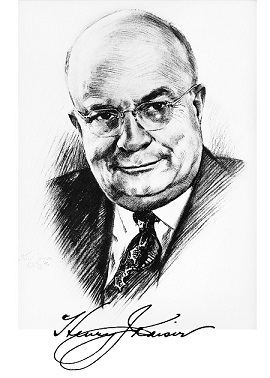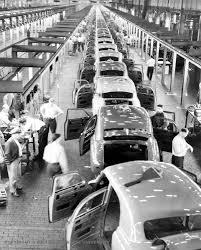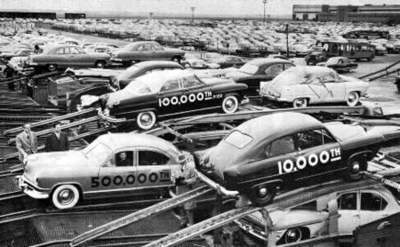The Auto Channel Feature Story +VIDEO
 Henry J. Kaiser |
KAISER AUTOS: PART 2
by Bob Hagin
SEE ALSO KAISER AUTOS: PART 1
July 4, 1997
Students of the history of World War II needn't be told that Henry J. Kaiser was a West Coast industrialist who flew in the face of convention. He constructed roads and buildings at breakneck speed by avoiding conventional methods, built ships for the government at an unheard of rate by using mass-production methods, and built his own model town near Portland to house the families of his shipyard workers. There seemed to be nothing Kaiser couldn't do and do it in his own way - until he entered the post-war American auto building business. And he almost made it there, too.
When Kaiser teamed up with Joseph W. Frazer, an old Detroit hand, he
was sure that his charisma and supplier contacts would cut through the
red tape that entangled the supply of raw materials and the production
of auto making machinery. He wanted to get a jump start on the older,
more established car builders, and for a while it worked. He leased and
then bought the multi-acre Willow Run production plant near Detroit a
few months after he and Frazer incorporated in July of 1945.
 |
Kaiser wanted to build revolutionary small, economical, inexpensive front-drive cars but soon realized that Frazer's plan was to build conventional six-seaters using proprietary components that would put new base-line Kaisers and upscale Frazers into the hands of car-hungry Americans before the rest of the industry got into gear. While other American car makers were offering warmed-over versions of their 1942 models, K-F dealers were showing (and selling) from-scratch 1947 Kaisers and Frazers late in 1946. Both were slab-sided "modern" designs that differed from each other mainly in trim and detail, but springing from a clean drawing board as they did, they were cars that the public had never seen before. The Kaiser was aimed at the tradition buyers of Fords, Chevrolets and Plymouths as well as those Nashes and Studebakers that fell into the lower-priced market niche. The upscale Frazer went up against Buick, Oldsmobile, Mercury, Dodge, Desoto and other "Big Three" offerings, plus the Hudson and Packard Clipper. In short order, K-F outsold all the other American independents and was nipping at the heels of the Detroit heavyweights. In those heady few years that followed the end of the war, we were all sure that there was nothing Henry Kaiser couldn't do.
And then things began to go wrong. Kaiser and Frazer, never the best of friends, began to have serious disagreements on the direction that K-F should take. As the rest of the industry began to catch up with new designs and short-stroke overhead valve V8 engines, Frazer pushed for downsizing and putting investment money into the development of future products, But Kaiser refused and insisted on overproducing the now-aging K-F cars. In 1949, little more than half of the K-F cars that were built were sold and some even had to be renumbered and sold as bargain- basement 1950 models. Money that should have gone into the development of a modern V8 engine was spent on an innovative but unsuccessful compact, the Henry J two-door fastback. That left the future Kaiser and Frazer full-sized cars with side-valve six cylinder engines that were already dated when they appeared in the first cars in 1946.
Frazer, sensing imminent disaster, eased himself out of the
day-by-day operations of the company and by 1950 was almost completely
disassociated from the organization that bore his name.
But Kaiser pressed on. Although the last version, the beautiful "Anatomic Design" sedan (a creation of Dutch Darrin, a famous designer of the era) was years ahead of its time, it wasn't enough to turn the company's fortunes around. The car maker that was America's meteoric sweetheart in 1946 was a washed-up has-been when its last versions were sold as 1955 models.
But Henry J. Kaiser wasn't ready to bow out of the auto world just yet. The body dies and other manufacturing equipment were shipped to Argentina, where Kaiser went into partnership with the Argentine government to produce the Kaiser Carabela until 1962. Kaiser bought the failing Jeep maker Willys-Overland in 1953, transformed it into Kaiser-Jeep which produced that world-famous off-roader and its civilized cousin, the Wagoneer.
At the age of 72, Kaiser "retired" to his home in Hawaii, leaving his son Edgar in charge of the Kaiser empire. While in Hawaii, he built a cement plant, the purpose-built tourist city of Hawaii Kai, as well as entering into the radio and TV business there. He also spent his "spare time" promoting what is the largest health-maintenance organization in America, the Kaiser-Permanente Group.
Henry J. Kaiser died in Hawaii in 1967 and while the rest of the industrialized world remembers him as an industrialist almost without equal, auto historians venerate him as the maverick auto builder who almost made it.



